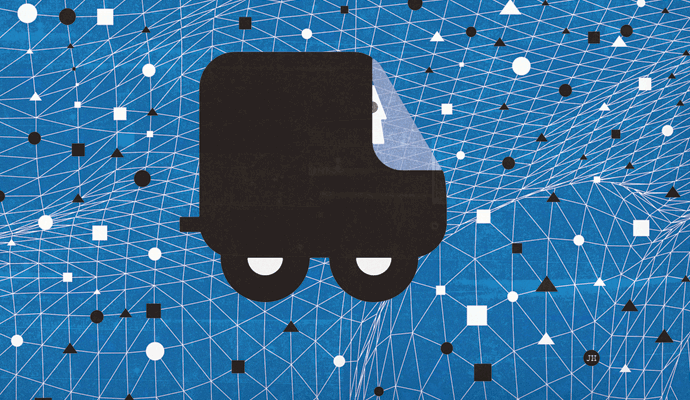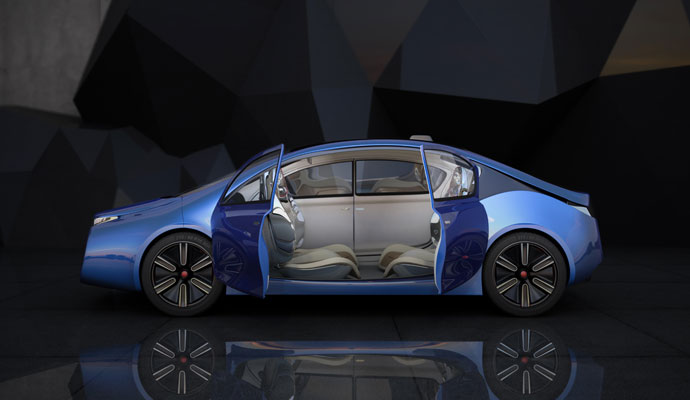The Intelligent Highway: A Smart Idea?
Roadways that give drivers safety updates and ease congestion may finally become part of U.S. transportation infrastructure.
It’s a persistent dream of transportation professionals that vehicles on American roads and highways will be wirelessly connected to computerized systems that will boost safety and reduce congestion. The advanced communications networks that form such a system might, for example, inform drivers about to make a left turn that oncoming traffic is moving too fast to proceed safely, or perhaps send drivers a warning of an accident or of congestion ahead — a big improvement on the electronic highway signs that are often difficult to read or display outdated information. These systems could also help drivers sidestep gridlock by suggesting an alternate route; help locate and reserve a parking space; provide information that warns drivers of changing traffic patterns; automatically adjust the timing on traffic signals along the route; and reduce traffic during busy periods by dynamically assessing fees for driving on the most congested routes.
Such systems would do much to reduce the 43,000 traffic fatalities that occur each year at a cost of US$230 billion to the U.S. economy and to reduce bottlenecks that have turned some stretches of America’s highways and urban centers into virtual parking lots. The U.S. transportation infrastructure — as well as the transportation infrastructure in much of the world — is reaching the limits of its capacity.
Experiments to create intelligent highway systems are not new. The U.S. Department of Transportation (DOT) tested a system of road sensors in San Diego 10 years ago that used radar, lasers, and cameras to send real-time information to onboard computers that controlled braking, acceleration, and steering. Although groundbreaking, the program proved too intrusive for most drivers, who were just getting used to cruise control. Since then, other federal or state programs have tested similar systems, and auto manufacturers have tested such smart features as adaptive cruise control, which automatically adjusts speed so that the car maintains a safe distance from the vehicle in front of it.
Although certain elements of an intelligent road system have proven successful, such as traffic signal systems that automatically control the flow of cars to allow emergency vehicles to safely navigate busy intersections, none of the experiments or component systems has yet blossomed into full-fledged, connected, system-wide networks. One reason is financial: Local governments lack sufficient funding to launch and maintain smart roadways alone and without access to sophisticated and well-drawn cost-benefit analyses, and state and municipal authorities are unable to produce a good economic argument to raise enough money for these systems. In addition, confusion lingers over which business models will ensure that systems will be financially viable, can be maintained over the long term, and will operate seamlessly across the nation.
Progress toward this vision has been slower than many advocates would like: They note that it’s been five years since the DOT secured rights from the Federal Communications Commission to use the Dedicated Short Range Communications (DSRC) 5.9 GHz radio band exclusively for safety applications, including collecting real-time information from moving vehicles. But there actually has been movement. By the spring of 2008, tests of the concept will take place in Michigan and California. They will, among other things, capture weather-related data from vehicles based on windshield wiper use, wheel traction, and braking efficiency and then broadcast this information instantaneously into other vehicles or post it on road signs.
Meanwhile, stakeholders — including the DOT, state authorities, automakers, radio and computer equipment manufacturers, telecommunications services providers, and toll road operators — are watching three sets of initiatives that may shed light on which technologies and business models make the most sense as a national public policy. Any of these experiments (each is intended for a different purpose and sponsored by a different entity) could become the basis for full-fledged intelligent highway programs:
Congestion pricing: Los Angeles, New York, Seattle, and San Francisco, among other cities, are considering charging vehicle operators more to use roads, bridges, and tunnels during peak hours. In some variations, these congestion-pricing systems would be invisible to drivers — they would simply get a bill at home for driving in certain places at certain hours or their credit card accounts would be automatically charged. But other systems would communicate to the driver with messages such as: “If you take this road, you will be charged this much. If you use another route, you will pay much less.” Or perhaps: “If you drive ahead at this hour, you will pay $10. But if you delay your trip until 10 a.m., it will be free.”
One exciting feature that could be incorporated into future systems is the ability to “know” how many people are in the vehicle, as well as how much pollution the car generates. Drivers who carpool might be rewarded with lower charges, and operators of vehicles with higher engine emissions might pay more. Local politics, however, may slow the development of these systems. New York City Mayor Michael Bloomberg, for example, proposed a congestion-pricing system in 2007; the city council, state assembly, and state senate are now considering a modified version of the plan, which would bring in additional revenue and make the city “greener” by reducing the amount of individual vehicles.
Communications networks and connected cars: Google, Microsoft, Sun Microsystems, and Cisco Communications have announced plans to develop technology for advanced transportation communications networks or automobile operating systems, or to provide applications and supply content to new fleets of cars that are connected to the networks. With the potential to connect 150 million vehicles to the Internet through highway communications, these companies may have sufficient commercial incentive to launch the necessary technological platforms with little government funding. As the quantity and quality of real-time information increases within a system of connected vehicles, such companies could recoup their investments by charging money for traveler information, maps, and even infotainment systems.
Cashless tolls: North Carolina, Texas, Colorado, and Florida are considering the adoption of cashless open tolling systems. North Carolina is currently considering whether to incorporate DSRC 5.9 GHz technology. The state is performing a “head-to-head” evaluation, ranking the 5.9 GHz standard against the 915 MHz technology used by the other three states to support older cashless tolling systems like E-Z Pass, SunPass, and E-Go. If the 5.9 GHz technology stacks up well, it may become the choice for smart highway communications on many other tolling systems, while also providing safety and security screening. In the end, financial considerations may play a big role in North Carolina’s decision: Private-sector proponents of 5.9 GHz technology and open standards are offering to pay to build the cashless tolling network and guarantee a high level of net profit to the state. That, in itself, reflects a significant amount of confidence in the communications technology.
From a policy perspective, there’s little question but that an open standards approach, which would allow all states to use the same technology and thus allow drivers traveling from one area to another to receive the information offered in the new locale, would be best. If this approach is successful in North Carolina, other states and cities might have more incentive to embrace it and avoid the continued nightmare of balkanization — numerous proprietary solutions separating one network from another and creating a patchwork of systems around the country that requires drivers to purchase multiple service offerings to travel from state to state. Balkanization has slowed the adoption of a seamless, nationwide system. Among the downsides of open standards, however, is a public safety issue. If a driver in North Carolina has grown used to a robust network of services — for example, a system that warns when oncoming cars are traveling so fast that a left turn would not be wise — what happens when the driver enters another state that provides some similar information but not this particular capability? In addition, a proprietary toll system may not be easily expanded to provide additional services later on, such as parking information, traffic data, intersection warnings, and weather updates.
From these efforts to study and test the many applications of an open DSRC 5.9 GHz radio band, key findings are expected to emerge about which technologies are most viable, what further standards are needed, and which business models will be the most effective in developing intelligent highways. Nonetheless, even with these gains, rolling out such a system nationally will not be an easy endeavor, primarily because producing a consensus about the best road map for the highway of the future promises to be a Herculean task. Still, it seems certain that because this concept makes eminent sense from a public policy, mobility, and safety perspective — and even provides numerous possibilities for private companies to generate significant revenues — there will before long be a sufficient meeting of the minds to produce a system that meets its many lofty expectations. ![]()
Joyce Wenger (wenger_joyce@bah.com) is a principal with Booz Allen Hamilton in McLean, Va. She specializes in management, research, analysis, system integration, and software engineering as they apply to transportation systems and technologies.
Jack Opiola (opiola_jack@bah.com) is a principal with Booz Allen in London. He specializes in intelligent transport systems, including road pricing and congestion charging policy, strategy, and technology.
Tony Ioannidis (ioannidis_tony@bah.com) is a principal with Booz Allen in McLean, Va. His expertise is in developing IT solutions for mobile data communications, in areas including transportation, telematics, and integration of RFID in transportation logistics and supply chain.



